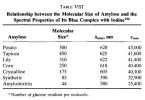Hi Persej, have you done any research about Iodine-starch complexes?
Yes, I did a lot of study on that topic. Some of the findings I already shared in this topic. I plan to share some more things after I go over them again.
In case you did it, I want to mention that if the starch starts to be digested then you have the release of I3 - and I5 - (the same Lugol's) in the digestive system. If the starch degradation is very fast, which is probable, then it is as though you were ingesting Lugol's.
Well, that is the question of all questions. What comes out of the starch after you digest it? That is something that I still haven't found an answer. After my experience with Lugol's and corn starch, I can assure you that what comes out of it is quite different than Lugol's.
The only utility I see for this way of ingesting iodine is that if the carbohydrate that you are using is a bit difficult to attack by the enzymes, then the iodine has the chance to be released maybe in parts of the digestive systems which Lugol's can't reach.
Yes, that is one of the benefits of this. Especially with potato starch since it's amylose molecules are much longer than corn's amylose so they are digested more slowly.
I will be interesting to try with different types of starch which will change the rate of liberation of iodine and the place of the system which iodine can reach.
I most strongly advise against experimenting with the other starches, especially with the corn starch since it gives purple and not blue iodine. Those who are sensitive to potato starch could perhaps try the tapioca or arrowroot starch, but I have no experience with them so I can't guarantee anything.
I give you the table from this magazine that talks about starch-iodine complex on page 264, in which you can see that the type of starch makes a big difference in color: Advances in Carbohydrate Chemistry and Biochemistry


